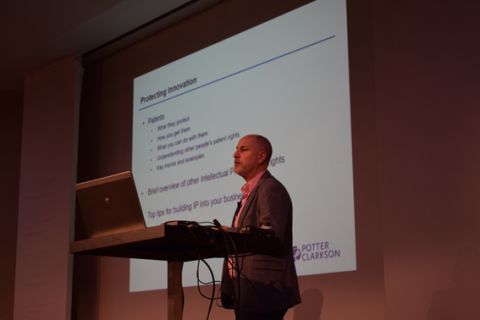Industry is experiencing an era of increasing cooperation. Most significantly, cross-sector collaboration has become an important strategy. It is clear that such collaboration can have a catalytic effect on progress, but it can also create difficulties, especially when it leads to commercial success. A recent example was provided by the so-called “smartphone wars”, where the software and hardware companies involved in collaborations that resulted in significant innovations within the telecommunications sector subsequently became embroiled in lengthy legal battles with one another concerning the enforcement of intellectual property rights (IPR) for the lucrative emergent technologies.
 Darren Mitchell addressing the international conference on Nonwovens for High-performance Applications on ways to protect innovation.
Darren Mitchell addressing the international conference on Nonwovens for High-performance Applications on ways to protect innovation.Global textiles companies have a long-established and sophisticated approach to IPR, traditionally being fiercely protective of their ideas and innovations. However, they too are now having to collaborate with commercial and academic partners from other sectors. Moreover, these collaborations often include the supply chains of all the principal partners.
With so many vested interests involved, there is a need for all these parties to exercise caution before they get to work. Each of the partners should have a clear strategy concerning their own IPR, for instance, knowing what they want to retain and what they are prepared to compromise for the overall success of the project.
To help achieve this, before entering into a commercial collaboration any business would be advised to take two steps:
- perform an internal audit of IPR;
- document the existing IPR of the partners.
An internal audit helps the business understand what it is bringing to the potential partnership, as well as whether it has adequate protection for its ideas and innovations. Invention and ownership are entirely different and if a business does not have proper ownership, it cannot fully realize the commercial benefits of its innovations. There are different forms of protection for IPR and businesses need to understand how each can best be exploited.
In the absence of a non-disclosure agreement (NDA) or adequate IPR protection, a business should not discuss its ideas with anyone outside of the organization.
Ensuring there is a clearly defined, written description of what each partner is bringing to the collaboration usually forms part of their formal agreement and helps to avoid any subsequent disputes. A record of the relevant existing IPR of each partner is an important part of the description.
However, there needs to be a degree of proportionality in any negotiations, otherwise the project may never get started. Overstating the case for IPR can sometimes be as detrimental as paying it too little attention, so after conducting an audit each of the partners should consider the true value of what they are bringing to the relationship.
Finally, once the project is underway, the partners need to keep the topic of IPR on the agenda for their meetings. Regular review as part of any communication is vital to a healthy and sustainable collaboration.
Technological advances in the production of industrial textiles are opening-up new and exciting opportunities for businesses throughout the supply chain, transforming the way products are produced and used. In order to make the most of these advances, it is increasingly common for businesses to cooperate, combining their individual developments to great effect.
In order to ensure that the profits from successful collaborations are shared fairly and not spent on subsequent legal battles between the former partners, each would be wise to review these simple steps before committing to an agreement.
 Mitchell's colleague Deborah Maxwell will be addressing the International Conference on Textile Coating and Laminating in 2019 with advice about how to respond when competitors steal your ideas or accuse you of doing the same.
Mitchell's colleague Deborah Maxwell will be addressing the International Conference on Textile Coating and Laminating in 2019 with advice about how to respond when competitors steal your ideas or accuse you of doing the same.